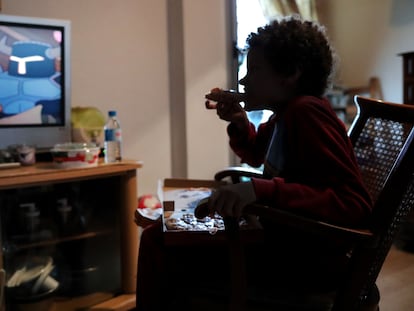Food neophobia, or when children do not want to try new foods
Minors refusing to eat new foods is usually a temporary problem between two and six years of age, and does not commonly lead to an eating disorder


Children’s appetite and eating behavior is one of the most common reasons for parents’ concern and why they consult with a pediatrician, according to professor of Pediatrics Rosaura Leis of the University of Santiago de Compostela, who is also the coordinator of the Nutrition and Breastfeeding Committee of the Spanish Association of Pediatrics. Although it must be taken into account that, as stated in the article Falta de apetito (Lack of appetite), published in 2016 by the Spanish Association of Primary Care Pediatrics, “eating well or badly is a relative concept that is influenced by social norms and the perceptions and beliefs of the different members of the family (...) That is why in many cases children’s appetite and eating behavior are a cause for concern among parents.”
The child’s reaction could be due to the fact that they have food neophobia, that is, “the aversion some children have towards eating new foods, especially around age two, when they start eating with the family,” according to Leis. The expert states that around 20-40% of parents report eating difficulties with their children including showing little interest in food, eating slowly, and choosing to eat certain foods over others. According to dietician and nutritionist Elena Toledano, neophobia is a common phenomenon that is normally a mild and transitory problem and that has a lot in common with picky eating, or having little appetite. Of course, they are not the same.
Although food neophobia has no specific cause, Toledano understands that it is part of a normal physiological stage that children can go through at some point after weaning and that usually reaches its peak between two and six years of age and then tails off. “We know that there is a very early link between food neophobia and breastfeeding,” the nutritionist continues, “a gateway for encountering a wide range of flavors that have been previously ingested by the mother, which means that it will help with accepting new foods later, and it establishes preference for these flavors in weaning foods.”
The foods that children most frequently reject in these early stages are fruit, vegetables, and fish. The reason child’s palate is prepared for sweet things by default, while the other flavors — such as bitter or salty — have to be learned, according to Leis. To teach them, the expert recommends introducing complementary feeding following the pediatrician’s advice. Start with a variety of foods and textures according to the child’s stage of development. If they reject the flavors that they are given, Leis’s advice is repeated exposure to those new foods the child does not show a preference for, and encourage them to try them in small amounts in a relaxed environment: “There are flavors that need to be tried up to nine or 10 times to start liking them. It is not about forcing the child, but about the food being on the family table and being tried repeatedly.”

Toledano also suggests letting the child experience their own sensations of appetite and satiety and, when possible, letting them eat alone: “This helps them feel in control of what they are eating. Forcing children to eat foods that they reject, as well as prohibiting those that we believe are not good for them, is not the solution in these cases. It only exacerbates the power struggle at the table and upsets the child who is a picky eater. Most children love foods that are rich in carbohydrates, such as rice, pasta, and potatoes. It is good that they love those foods, but not when they end up displacing the others,” continues Toledano. That is why the dietitian recommends combining both food groups: “Serve the vegetables themselves with foods that are high in carbohydrates and proteins, such as cereals, legumes, meats, fish, and eggs.”
All these ideas and recommendations are made to ensure that nutrition does not focus only on the idea of eating food. “It should be an enjoyable and social relationship, and the child has to be introduced to it and the culinary traditions of their area,” explains Leis. “The family, parents and caregivers, and the school, together with the pediatrician, will — and should — play a very important role in developing healthy lifestyles, in which nutrition is essential,” she adds.
When it becomes an eating disorder
Although food neophobia is generally temporary, it can sometimes become a serious mental health problem. Leis cites the a report published in 2020 in Pediatría Integral, according to which 3% of children continue with persistent eating issues beyond the age of 6. “This gives rise to a functional, social, and/or nutritional impact. In these cases, the child is considered to have AFRID (Avoidant or Restrictive Food Intake Disorder). This disorder is part of the diagnostic group of feeding and eating disorders,” the professor of pediatrics points out.
This pathology poses a risk of nutritional deficiencies and/or low weight and psychosocial impact. “To get a diagnosis, they must present failure to meet nutritional and/or energy needs, which is demonstrated by significant weight loss, and/or deficiency of some nutrient, and/or need for nutritional supplements or special nutrition, and/or interference with psychosocial integration.”
Sign up for our weekly newsletter to get more English-language news coverage from EL PAÍS USA Edition
Tu suscripción se está usando en otro dispositivo
¿Quieres añadir otro usuario a tu suscripción?
Si continúas leyendo en este dispositivo, no se podrá leer en el otro.
FlechaTu suscripción se está usando en otro dispositivo y solo puedes acceder a EL PAÍS desde un dispositivo a la vez.
Si quieres compartir tu cuenta, cambia tu suscripción a la modalidad Premium, así podrás añadir otro usuario. Cada uno accederá con su propia cuenta de email, lo que os permitirá personalizar vuestra experiencia en EL PAÍS.
¿Tienes una suscripción de empresa? Accede aquí para contratar más cuentas.
En el caso de no saber quién está usando tu cuenta, te recomendamos cambiar tu contraseña aquí.
Si decides continuar compartiendo tu cuenta, este mensaje se mostrará en tu dispositivo y en el de la otra persona que está usando tu cuenta de forma indefinida, afectando a tu experiencia de lectura. Puedes consultar aquí los términos y condiciones de la suscripción digital.
More information
Últimas noticias
Maduro to be tried in the US for narcoterrorism and corruption
Maps of the US attack on Venezuela: Targets, airspace and deployed fleet
Venezuelans in exile: ‘This could be the end of a very dark chapter for Venezuela, but also the beginning of a time of uncertainty’
Key points of the military attack on Venezuela: Early morning bombings and a ‘captured’ president
Most viewed
- Alain Aspect, Nobel laureate in physics: ‘Einstein was so smart that he would have had to recognize quantum entanglement’
- David King, chemist: ‘There are scientists studying how to cool the planet; nobody should stop these experiments from happening’
- Mexico completes its trade shift with the entry into force of tariffs on China and countries without trade agreements
- Reinhard Genzel, Nobel laureate in physics: ‘One-minute videos will never give you the truth’
- Oona Chaplin: ‘I told James Cameron that I was living in a treehouse and starting a permaculture project with a friend’










































